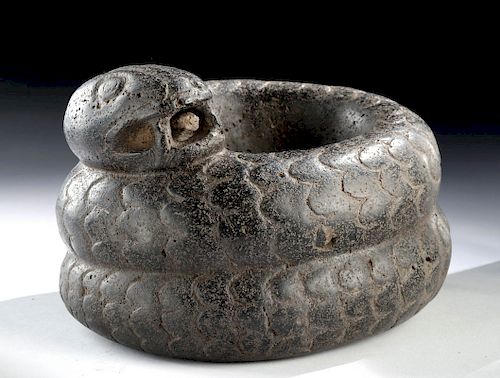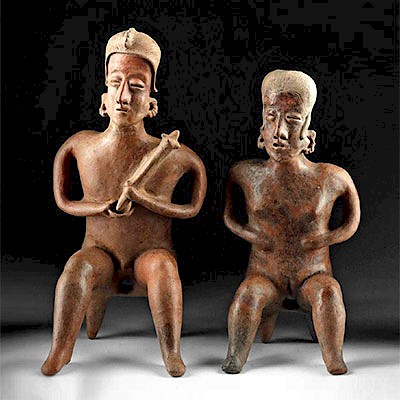Fabulous Aztec Basalt Rattlesnake Mortar
Lot 137
About Seller
Artemis Gallery
686 S Taylor Ave, Ste 106
Louisville, CO 80027
United States
Selling antiquities, ancient and ethnographic art online since 1993, Artemis Gallery specializes in Classical Antiquities (Egyptian, Greek, Roman, Near Eastern), Asian, Pre-Columbian, African / Tribal / Oceanographic art. Our extensive inventory includes pottery, stone, metal, wood, glass and textil...Read more
Estimate:
$10,000 - $15,000
Absentee vs Live bid
Two ways to bid:
- Leave a max absentee bid and the platform will bid on your behalf up to your maximum bid during the live auction.
- Bid live during the auction and your bids will be submitted real-time to the auctioneer.
Bid Increments
| Price | Bid Increment |
|---|---|
| $0 | $25 |
| $300 | $50 |
| $1,000 | $100 |
| $2,000 | $250 |
| $5,000 | $500 |
| $10,000 | $1,000 |
| $20,000 | $2,500 |
| $50,000 | $5,000 |
| $100,000 | $10,000 |
| $200,000 | $20,000 |
About Auction
By Artemis Gallery
May 23, 2019
Set Reminder
2019-05-23 10:00:00
2019-05-23 10:00:00
America/New_York
Bidsquare
Bidsquare : Exceptional Day 2 Ethnographic Tribal Fossils
https://www.bidsquare.com/auctions/artemis-gallery/exceptional-day-2-ethnographic-tribal-fossils-4136
Day 2 of an important 2-day auction featuring exceptional ethnographic art from around the world. Today's sale will feature Pre-Columbian from the ancient americas, Native American, African / Tribal, Oceanic, Spanish Colonial, and incredible Fossils. Artemis Gallery info@artemisgallery.com
Day 2 of an important 2-day auction featuring exceptional ethnographic art from around the world. Today's sale will feature Pre-Columbian from the ancient americas, Native American, African / Tribal, Oceanic, Spanish Colonial, and incredible Fossils. Artemis Gallery info@artemisgallery.com
- Lot Description
Pre-Columbian, Mexico City region, Aztec, Post-classic Mexico, ca. 1300 to 1500 CE. A dramatic coiled rattlesnake, carved from black basalt, with its center hollowed out to form the bowl of a mortar. The neatly spaced scales, carefully delineated rattle, and large head of the animal are all wonderfully displayed here. The head has its mouth open, its fangs at the ready, though its coiled posture does not suggest an attack. The eyes are wide and incised, the nostrils raised. The symbolism of the snake was central to Aztec religion; the mother goddess, Coatlicue, takes her name from the Nahuatl for "snake" and "skirt" - "she who has the skirt of snakes". In numerous carvings known from Tenochtitlan and other Aztec cities, she is depicted wearing her skirt made of writhing rattlesnakes, her head formed by the heads of two serpents who face each other, wearing a necklace made of human skulls, hearts, and hands. Beyond their association with the goddess, the snake's skin shedding was seen as symbolic of the cyclical nature of life and agriculture. Size: 7.55" W x 5" H (19.2 cm x 12.7 cm)
Provenance: private southwestern Pennsyvania, USA collection
All items legal to buy/sell under U.S. Statute covering cultural patrimony Code 2600, CHAPTER 14, and are guaranteed to be as described or your money back.
A Certificate of Authenticity will accompany all winning bids.
We ship worldwide and handle all shipping in-house for your convenience.
#146309Intact, with surface wear commensurate with age, including some weathering and pitting. Interior of mortar shows signs of having been used with some scratching/smoothing of the surface. Excellent preservation of detail and form.Condition
- Shipping Info
-
All shipping is handled in-house for your convenience. Your invoice from Artemis Gallery will include shipping calculation instructions. If in doubt, please inquire BEFORE bidding for estimated shipping costs for individual items.
-
- Buyer's Premium



 EUR
EUR CAD
CAD AUD
AUD GBP
GBP MXN
MXN HKD
HKD CNY
CNY MYR
MYR SEK
SEK SGD
SGD CHF
CHF THB
THB
















